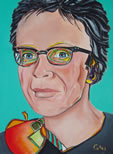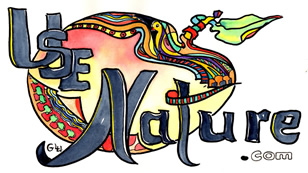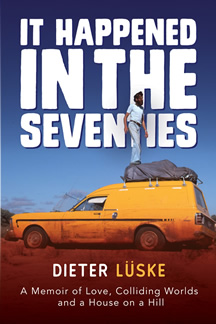useNature.com ... Homeopathy
Homeopathy Reviewed
Holistic Health - Natural Therapy
useNature's Lifestyle Magazine & Holistic Articles
Homeopathy Reviewed
... how does Homeopathy work? - Homeopathy - emerging recognised nanomedicine?
Article by Dieter L. Editor of useNature
What is Homeopathy ?
Homeopathy, despite being practiced worldwide, has its fair share of controversy attached to it. What is it that triggers the often exaggerated negative press about homeopathy? - It certainly has nothing to do with being low cost or non-toxic.
It seems that some Doctors are of the unfortunate opinion that, by advocating Homeopathy, patients are deprived of “scientific medical treatment". Nothing could be further form the truth.
Homeopathy is not easy to understand. People who swear by it, to a great degree, do so because of the good results they have experienced, and probably less because they know exactly of how it works.
It is always easier to understand a medical drug - the function and reaction can be scientifically explained, and the science behind it seems to instill confidence in a patient, even so side effects are part of the picture, and often have long lasting negative effects.
With Homeopathy, there are no side effects, it either works or it doesn’t.- It's as simple as that.
Lets talk for a moment hypothetically ... why it may not work.
To do that, one needs to know the whole functionality of Homeopathy, and I will come to that in a moment.
First, one needs to understand that, if Homeopathy does not work, it has nothing to do with the homoeopathic medicine.
It has something to do with prescribing the “right” remedy for one specific patient.
There are more than 2000 different remedies to choose from, and to arrive at the right remedy takes careful and time consuming case taking. To make it even more complicated, the Homeopath not only needs to consider the right remedy, but also the right potency (or strength) of a remedy.
The key point is that a prescription works by the law of “Likes cures Like”, and the difficulty lies in the fact that 2 people presenting with a similar headache, may each need a totally different remedy to achieve the “like cures like” patient picture.
In allopathic medicine, it does not matter how many people present with a headache. Everyone can take the same “pain killer”.
A medical drug works on the principle of blocking a function, rather than stimulating healing.
By stimulating healing however, you may not get your headache back the next day.
Whereas taking a pain killer, once the blocking effect has worn off, you may have your headache back, because nothing has been cured, healed or improved.
Homeopathic medicine is acting deeper, by concentrating its action on the cause of the problem.
This principle makes it difficult to do a medical type of double blind test.
It would be nearly impossible to find 100 people of a total identical case picture, where only one homeopathic medicine would fit the picture, and to give that medicine to 50 people and a placebo to the other 50 people.
However, there have been tests and trials like that, where homeopathic medicine has been prescribed by what is known as key word prescribing. That means, rather than doing a proper case taking, just the main symptoms have been considered, and therefore, just one medicine was tested against a placebo.
One can’t expect a 100% positive test result under those circumstances. However, in any double blind tests undertaken, the homeopathic always “scored” better than the placebo.
I am not a scientist, nor a medical Doctor, and as such may not be an appropriate person to attempt to explain Homeopathy.
However, having studied and used Homeopathy as a patient and as a practitioner for over 40 years must count for something. Maybe I also should note, that in no way do I have the possibility to achieve financial or any other gains by writing about Homeopathy.
I have had countless cases, where the healing effect of Homeopathic remedies was proven to me, over and over again. Unfortunately I have had also lots of cases where the remedies only just made a slight difference, and other cases where absolutely nothing happened.
That seems to reflect negatively on Homeopathy. However, as I stated before, it just may mean that I haven’t be able to find the right remedy, or even that a possible right remedy has not yet been found. After all, that’s what is happening to all medical drugs… they are not curative. It’s mainly maintenance, and for most conditions one drug is not even enough, and possible side effects may need to be treated by more drug prescriptions.
In other words, drugs, as necessary as they may be for lots of life threatening diseases, are far from being perfect. There is even the possibility, if similar amounts of money would be invested in researching Homeopathy, that more cures would be possible.
Time to investigate some home truth about Homeopathy, and the validity to use it as medicine.
What are the “Law of Similars”, like cures like, and "Provings"?
Homeopathy was developed In Germany by Dr Samual Hahnemann (1755-1834); an orthodox physician. He was also a researcher, botanist, chemist and even a multi linguist and translator.
While translating a medical text, he disagreed with a statement about Cinchona (quinine bark extract) in relation to a treatment for swamp fever. He decided to take a dose of Cinchona himself, and to his surprise, he developed symptoms similar to swamp fever. All symptoms disappeared when he stopped taking Cinchona. - He even tested it on his family, with similar results.
This procedure was effectively the first “proving” for a homeopathic medicine, according to the “Law of Similars”, like cures like, meaning a remedy that is effective against a disease will produce “similar” symptoms in a healthy person.
This is highly significant, especially when we considered the era, when medicine was practiced with crude drugs, blood letting and purging. It is also significant in another way; Homeopathy is always tested (provings) on humans. No animal ever had to suffer in the name of science.
Like cures like, was first mentioned by Hippocrates, the father of modern medicine. He stated; vomiting may be stopped, by being made to vomit, and any illness caused by one means can be treated successfully by similar means.
From this point on, Hahnemann began his life’s work. By 1810 he published "Organon der rationellen Heilkunde”. I am not sure in what year it was translated to English. Anyhow, the English title is “The Organon of Rational Medicine”. I have the Original German version… certainly not an easy read. Large parts of the book are directed against the medical procedures at that time, and he called the orthodox medical system “Old School”.
The allopathic approach at that time, and still today, works partly on “Opposites”, inhibiting reactions; like Anti-histamines, antibiotics, antacids, beta blockers, cough suppressants, anti-febrile medication.
Whereas Homeopathic works on “Similars”, where a substance that will produce disease symptoms, can also be used in a minute dose to stimulate a healing effect. - One has to argue - isn’t that a much more elegant way of healing?
One wonders why not more research has been applied to that scientifically proven method. I am not much in favour of conspiracy theories, but still, I can see the possibility that money may play a role. Homeopathic Medicines are cheap, and I don’t think they can be patented.
The law of Similars, like cures like, is probably not the main reason why certain people are against Homeopathy. - Apparently, the main reason is the seemingly endless dilution of the medicine, to the point where there is no possibility of the original material being present. In a way, that is understandable.
It basically means that medicine has been reduced to take a few drops of plain water, and how could that possibly work?
I am not sure if this has been explained anywhere yet to the full acceptance of the scientific world. But there can be no doubt that Homeopathy works, and it has been demonstrated right from the beginning, when Hahnemann started to use it, to the point where it is practiced world-wide.
It needs to be considered that all early Homoeopaths were trained allopathic Doctors, and they used Homeopathy because it worked, not because they tried to trick their patients.
At the time of the Second Cholera Epidemic of 1829 – 1851, the patients treated homeopathicly had a far higher recovery rate than their allopathic counterparts. In the third Epidemic, 1853–4, London's epidemic claimed 10,738 lives. However, the London Homeopathic Hospital was already established, and their death rate was far less than the allopathic one. All this may not explain why exactly a medicine diluted in water can possibly cure a disease, but it has proven that it can, which should have resulted in much more effort to research it to a much deeper level. Obviously, there are many theories and even research why it works. Even so, none seems to be conclusive as yet.
First, one has to understand that a homeopathic medicine is not just diluted with water. It is done in a very specific procedure, and without following that procedure, it actually does not work. This procedure is called “Potentisation”.
Potentisation and the Law of the Minimum Dose
Obviously as we have seen on the example with Cinchona, if you have swamp fever, you don’t want to take a large dose of crude Cinchona. To actually achieve a like cures like therapy, one needs to “dilute” or “potentise” the original medicine to make sure not to aggravate symptoms. For that reason, Hahneman has formulated the “Law of the Minimum Dose”, which simply means that the most effective dose is the minimum dose needed for a curative response.
This process involves two steps, first a dilution and secondly a specific way of shaking, called succussion.
The first dilution is called a “1x” (a decimal dilution), and it involves taking 1part of the medicine, adding it to 9 parts of water and shaking it hard 10 times. That is still considered normal, but now it gets interesting. - The next solution is called “2x”, and it involves the same procedure - taking 1part of the 1x medicine, adding it to 9 parts of water, and shaking it. That will continue till one has reached the desired potency, which may be 6x by example, which would be considered a low potency, with possible original material still within the water.
The Avogadro Limit
There is something called the Avogadro Limit, which means that by the time the dilution has reached 24x, none of the original source, not even a single molecule would be present.
Above dilutions are done by the decimal scale. Other dilutions are done using the centesimal scale, meaning taking one part of the medicine to 99 part of water, which will reach the Avogadro Limit by 12c. There are even higher dilutions.
It needs to be stressed that shaking or succussing each step of the dilution is the part that makes everything possible. Even so, no active molecule is present in a dilution above the Avogadro Limit. - There is an energy potential within the water molecule itself, which is the stimulating factor for creating a healing effect.
What is Reverse Logic?
I have kind of proven the above by what I call “reverse logic”. The example: a patient of mine, frequently consulting me for a sudden swelling of the tongue, resulting in various symptoms of pain, difficulties with speech and chewing. Nothing too serious, no specific cause could be found by her Doctor, who tried painkillers and antibiotics. - Symptoms usually dissolved after about a week, and sometimes it took a few months before a return of symptoms.
I treated her with a combination that I had used before. Even though I consider myself a classical Homoeopath, I could see a possible benefit of keynote prescribing, and was mixing 6x of Apis and 6 x of Belladonna, and told her to take 5 drops of that mixture under her tongue every 2 hours.
She called me that night to report that her symptoms had basically gone, and by next morning she was back to her normal self.
She kept a bottle of her medicine and used it whenever she needed it. I tried a higher potency, hopefully to stop her symptoms altogether, but couldn’t stop the reoccurrence. She did, however, agree to try a few other remedies, which failed altogether, and she always needed her original drops again.
On one occasion, I tried my “reverse logic” to prove that homeopathy works. I immersed the bottle of medicine into boiling water for a minute. I asked her to try that medicine, but gave her the original mix as well. (And no, I didn’t charge her. And yes, she agreed to give it a try.) By that night, she called me, asking me when she can take her old medicine. The new one was not working. She took her old medicine and symptoms had subsided in the morning.
Boiling the medicine would have disturbed the water molecules enough to release all the stored energy. At least that’s what I think. Even though I had believed in Homeopathy before, this volunteered experiment was certainly proof enough for me.
For the very scientific minded, there are lots of trials available. You only need to search the Internet for Homeopathic trials, and you will mostly find conclusions like this one >> “The objective results reinforce earlier evidence that homeopathic dilutions differ from placebo. Results showed a mean symptom reduction on visual analogue scores of 28% (10.9 mm) for homeopathy compared with 3% (1.1 mm) for placebo.”
The Arndt-Schultz Law
To explain it even further why low dosages of a medicine (or any substance) can have a profound effect, one can look at a law of pharmacology; “The Arndt-Schultz Law”, which is a suitable model to describe dose-dependant effects.
It states that;
-
“weak stimuli increases physiologic activity (Homeopathy)
-
moderate stimuli inhibits activity (medical drugs)
-
and very strong stimuli abolishes activity (toxic matters)
As I mentioned before, Homeopathy is seen as stimulating a healing response, whereas medical drugs are inhibiting functions.
What is Hormesis?
Hormesis describes favourable biological responses to low exposures to toxins and other substances and stressors. A pollutant or toxin showing hormesis thus has the opposite effect in small doses as in large doses. The hormesis concept is vigorously debated. The fact, that hormesis is important for chemical risks regulations is not widely accepted. - (I wonder why ? – sorry cynicism has no place here)
Even so hormesis is not well understood. It is conjectured that low doses of toxins or other stressors (homoeopathy) might activate the repair mechanisms of the body. The repair process fix, not only the damage caused by the toxin, but also other low-level damage that might have accumulated before, without triggering the repair mechanism. (see Wikipedia – Hormesis )
All these various facts, scientific research and trials prove that Homoeopathy is indeed a valid treatment method. The only conclusive evidence still missing is the possible mechanism of holding energy patterns within water molecules.
Homoeopathic Vaccination (prophylactic prescriptions)
There is just one more subject within homeopathy, which needs to be mentioned, prophylactic prescriptions or so-called homoeopathic vaccination.
This topic is extremely controversial and emotive.
First of all, I am not aware that Homoeopaths are trying to convince anyone to stop vaccination and use homoeopathic vaccination instead.
Secondly, if someone decides not to vaccinate, for whatever reason, then the least that could be said is “Homoeopathic vaccination is probably better than nothing at all”.
Having a look at vaccination, one can see that there are similarities. With medical vaccination, a small dose is used to stimulate or activate the immune system to react against a possible invasion of a virus. One could say, the medical system has adopted the principle of “like cures like”.
The main difference is that a physical reaction can occur, and sometimes to the detriment of the patient.
The other objection many people have is that the vaccine may contain many additional, often toxic chemical substances, which in turn can have a negative effect.
I am not arguing for or against vaccination.
As I mentioned, it is a highly emotive subject, and also for many, an assessment of the risks is required.
Which risk is greater?
To vaccinate and risk possible side effects, or not to vaccinate and risk possible infectious diseases?
Everyone needs to make up their own mind.
And one last observation, surely there is a difference of being vaccinated just a few times, and what is happening now, being vaccinated over 30 times and starting vaccination as young as at time of birth? - Have the multitude and accumulative possible negative effects of vaccination been thoroughly researched?
Article compiled by:
Dieter L. Editor of useNature
References:
Hahnemann Organon der Heilkunst ... and ..
http://link.springer.com/article/10.1007%2Fs10953-007-9215-5
http://www.homeopathyoz.org/downloads/Research%2001.pdf
http://www.homeoinst.org/database
http://het.sagepub.com/content/29/7/561.abstract
http://drnancymalik.wordpress.com/2013/01/23/epidemics-and-pandemics/
http://drnancymalik.hpathy.com/
 useNature Editor
useNature Editor
Dieter Lüske
N.D.-D.C.H.-D.M.H.-D.H
Buy Now
It happened in the seventies
A Memoir of Love, Colliding Worlds and a House on a Hill
Intriguing story of personal risk-taking, self-discovery and profound change.
Dieter Luske
author . writer . editor
Facebook Groups
© 1998 - 2025 useNature.com: Australia - Dieter Luske - Writer - Creative Lifestyle Portal - Natural Holistic Health - Books & Art -
Site Map - Terms / Privacy - Free Alpha Music | Photography | Natural Links |

